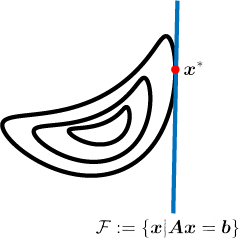Linear Constraint¶
In this lecture, we consider optimization problem where the unknown variable satisfies a linear constraint. Let f:\R^n → \R be a continuously differentiable real valued function and \mA \in \R^{m\times n} be a matrix with m\le n. The linearly-constrained optimization problem is
where \vb \in \R^m is a fixed vector. We assume that the matrix \mA has full row rank and the minimum value is finite and attained. The figure below shows interaction between the objective function f and the feasible set \mathcal{F}. The feasible set is the set of point that satisfy the constraint.

Reduced unconstrained problem¶
In the case of linear constraints as in \eqref{linear_constraint}, we can reformulate the problem into an unconstrained problem. In order to write the unconstrained problem, we note that the feasible set \mathcal{F} = \{\vx \in \R^n| \mA\vx=\vb\} can we equivalent expressed as the set \{\bar{\vx} + \mZ \vp |\vp \in \R^{n-m}\}, where
-
\bar{x} is any particular feasible solution , i.e. \bar{\vx} satisfies \mA\bar{\vx} = \vb, and
-
\mZ is a basis for \vnull(\mA).
So, any \vx that satisfies the linear constraint in \eqref{linear_constraint} can be expressed as \bar{\vx}+\mZ\vp for some \vp \in \R^{n-m}. This reduces the linear constrained problem \eqref{linear_constraint} to an unconstrained problem in n-m variables:
The above unconstrained problem can be solved to get an optimal \vp^* via any unconstrained method. The corresponding optimal solution to the constrained problem is then \vx^* = \bar{\vx}+\mZ\vp^*.
Optimality Conditions¶
Define "reduced" objective function for any particular solution \bar{\vx} and basis for null space \mZ as f_\vz(\vp): = f(\bar{\vx} + \mZ\vp). THe gradient of f_\vx at \vp is
The quantity \nabla f_\vz is called the reduced gradient. Let \vp^* be an arbitrary point and set \vx^* = \bar{\vx}+\mZ\vp^*. Then \vp^* is optimal only if
By construction of \mZ, we have \vnull(\mZ) = \range(\mA). Also, note that the fundamental subspaces in \R^n associated with \mA and \mZ satisfy
Thus, \nabla f(\vx^*) \in \vnull(\mZ\trans) if and only if \nabla f(\vx^*) \in \range(\mA\trans). Further, \nabla f(\vx^*) \in \range(\mA\trans) if and only if there exist a \vy such that \nabla f(\vx^*) = \mA\trans\vy. These relations lead to the following first-order necessary conditions.
Lemma (First order necessary condition) A point \vx^* is a local minimizer of \eqref{linear_constraint} only if there exists an m-vector \vy such that
-
(Optimality) \nabla f(\vx^*) = \mA\trans\vy = \sum_{i=1}^m \va_i y_i. Here, \va_i is the ith row of \mA.
-
(Feasibility) \mA\vx^* = \vb.
Note that the optimality statement in the above lemma can be equivalently expressed as \mZ\trans\nabla f(\vx^*) = 0, which is further equivalent to \nabla f(\vx^*)\trans\vp = 0 for all \vp \in\vnull(A). The vector y is sometimes referred to as "Lagrange multipliers".

Note that the Hessian of f_\vz at \vp is \nabla^2 f_\vz(\vp) = \mZ\trans\nabla^2f(\bar{\vx}+\mZ\vp)\mZ. We now state the necessary second-order condition.
Lemma (Second-order necessary condition) A point \vx^* is a local minimizer only if \mA\vx^* = \vb and \nabla^2f_\vz(\vx^*)⪰ 0. Equivalently, \vx^* is a local minimizer only if \mA\vx^* = \vb and \mZ\trans\nabla^2f(\vx^*)\mZ \succeq 0.
We now state the sufficient second-order optimality condition.
Lemma (Second-order sufficient condition) A point \vx^* is a local minimizer if it satisfies the following conditions:
-
(Feasibility) \mA\vx^* = \vb,
-
(Stationary) \nabla f_\vz(\vx^*) = 0, and
-
(Positivity) \nabla^2f_\vz(\vx^*) \succ 0.
Equivalently, \vx^* is a local minimizer if it satisfies the following conditions:
-
(Feasibility) \mA\vx^* = \vb,
-
(Stationary) \nabla f(\vx^*) = \mA\trans\vy for some \vy, and
-
(Positivity) \vp\trans\nabla^2f(\vx^*)\vp>0 for all \vp \in \vnull(A)\backslash \{\vzero\}.
Example¶
(Least norm solutions) Consider the following problem:
To find the least norm solution, we first state the corresponding first-order optimality condition. Without loss of generality, we may assume that the objective is f(\vx) = \frac{1}{2}\|\vx\|_2^2. Since \nabla f(\vx) = \vx, first-order optimality is
So, if the constraint set \mA\vx = \vb is x_1 + x_2 + \dots + x_n = 1, then the first order optimality condition yields
Thus, the minimizer is \vx = \frac{1}{n} \ve.
Algorithm¶
The reduced gradient method for solving linear constraint optimization problem is:
Algorithm (Reduced gradient method)
Given \vx_0 feasible and \mZ a basis for \vnull(\mA)
For k = 0, 1, 2, \dots
-
Compute \vg := \nabla f(\vx_k).
-
Compute \mH := \nabla^2f(\vx_k).
-
Solve \mZ\trans\mH\mZ\vp = -\mZ\trans\vg to get \vp_k.
-
Linesearch on f(\vx_k + \alpha \mZ\vp_k).
-
\vx_{k+1} = \vx_k + \alpha_k\mZ\vp_k.
-
Repeat until convergence.
The algorithm requires an initial feasible point and a basis for the null space of \mA. An initial feasible point is easy to obtain (for example, the least squares solution). One approach to obtain a basis for the null space is by considering the QR decomposition of \mA\trans. We will present an alternate way to construct the basis for the null space.
Permute the columns of \mA so that the matrix \mA can be represented as
where \mB is non-singular. Such a matrix exists because \mA is full rank. The matrix \mB is called a basic matrix and \mN is called the non-basic matrix. Then feasibility requires
The variables \vx_B and \vx_N are called basic variable and non-basic variable respectively. Note that \vx_B is uniquely determined by \vx_N, i.e. \vx_B = \mB^{-1}(b-\mN\vx_N), and \vx_N is free to move.
By construction, the matrix \mZ = \bmat-\mB^{-1}\mN\\ \mI\emat is a basis for the null space of \mA. This is because \mA\mZ = \bmat\mB&\mN\emat\bmat-\mB^{-1}\mN \\ \mI\emat = 0.